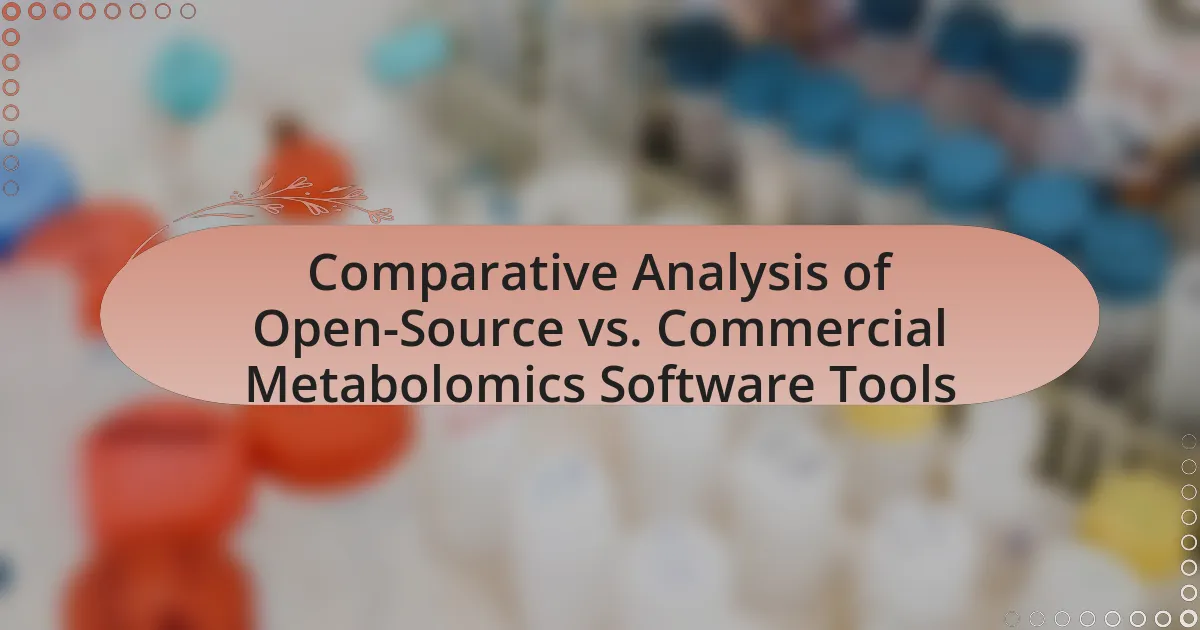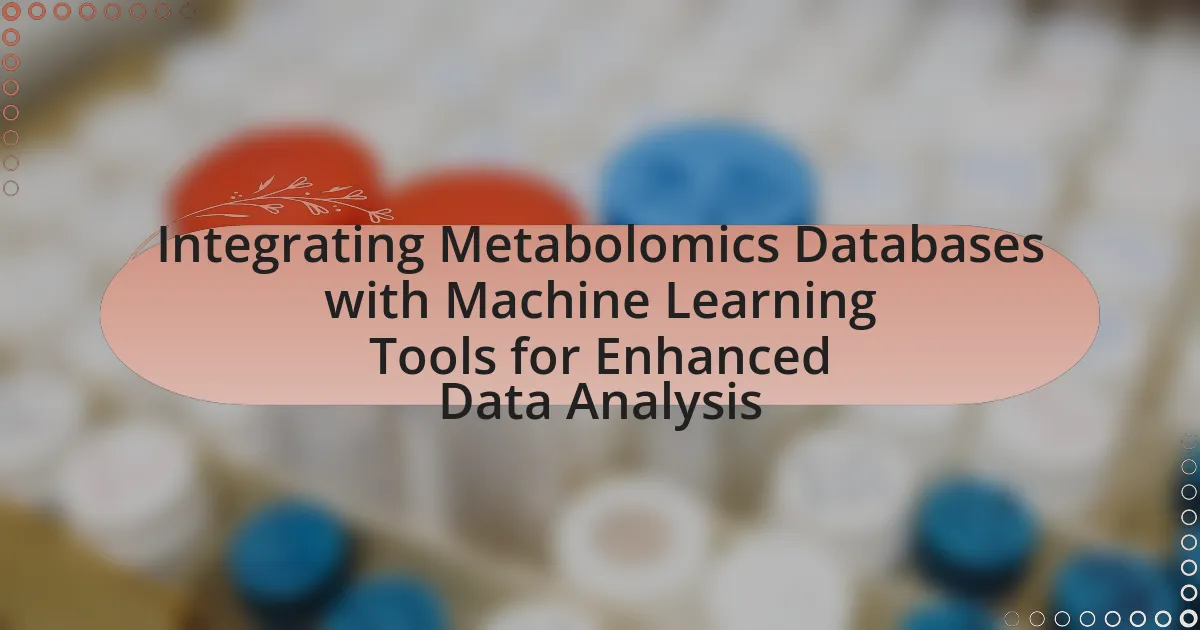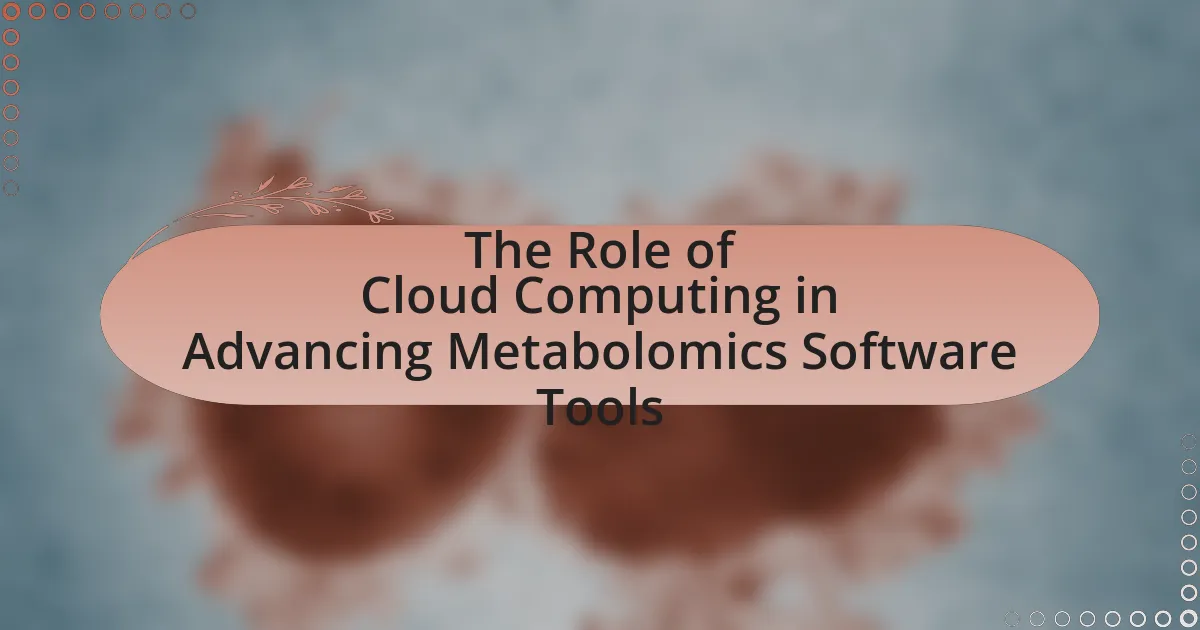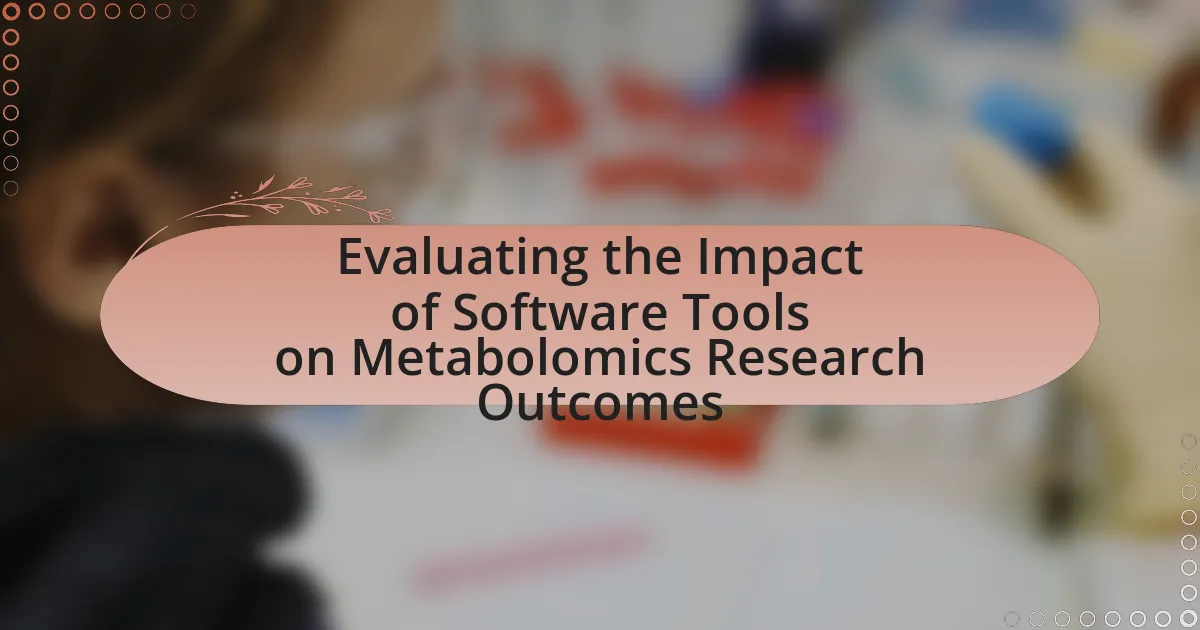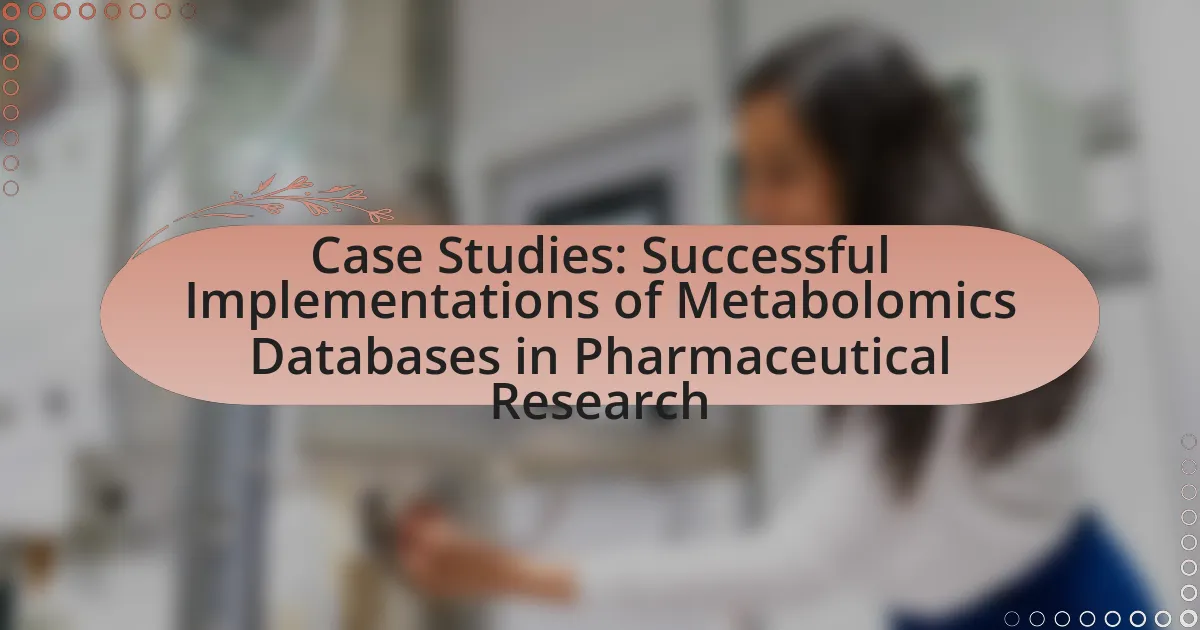The article provides a comparative analysis of open-source and commercial metabolomics software tools, highlighting their defining characteristics, advantages, and disadvantages. Open-source tools, such as MetaboAnalyst and XCMS, are characterized by their accessibility, collaborative development, and cost-effectiveness, while commercial tools like Agilent’s MassHunter offer user-friendly interfaces and dedicated support but come with high costs. The discussion emphasizes the importance of software choice in influencing research outcomes, accessibility, and collaboration within the metabolomics community. Additionally, it outlines criteria for selecting appropriate software based on specific research needs and best practices for effective utilization.
What are Open-Source and Commercial Metabolomics Software Tools?
Open-source metabolomics software tools are freely available programs that allow users to analyze and interpret metabolomic data without licensing fees, promoting collaboration and innovation within the scientific community. Examples include MetaboAnalyst and XCMS, which provide functionalities for data processing, statistical analysis, and visualization. In contrast, commercial metabolomics software tools are proprietary applications that require purchase or subscription, often offering advanced features, dedicated customer support, and user-friendly interfaces. Examples include Agilent’s MassHunter and Waters’ UNIFI, which are designed for high-throughput analysis and integration with specific hardware. The distinction between these two types of tools lies in their accessibility, cost, and the level of support provided, influencing researchers’ choices based on their specific needs and resources.
How do Open-Source Metabolomics Software Tools differ from Commercial Tools?
Open-source metabolomics software tools differ from commercial tools primarily in their accessibility and cost structure. Open-source tools are freely available for users to download, modify, and distribute, promoting collaboration and innovation within the scientific community. In contrast, commercial tools typically require a purchase or subscription, which can limit access for some researchers.
Additionally, open-source tools often benefit from community-driven development, allowing for rapid updates and diverse feature sets based on user feedback. For example, software like MetaboAnalyst and XCMS are continuously improved by contributions from users and developers. Commercial tools, such as those from Agilent or Thermo Fisher, may offer more polished user interfaces and dedicated customer support, but they can also be less flexible in terms of customization.
The choice between open-source and commercial tools ultimately depends on the specific needs of the researcher, including budget constraints and the desired level of support and customization.
What are the defining characteristics of Open-Source Metabolomics Software?
Open-source metabolomics software is characterized by its accessibility, collaborative development, and transparency. These software tools are freely available for users to download, modify, and distribute, which fosters a community-driven approach to innovation and improvement. The collaborative nature allows researchers to contribute to the codebase, enhancing functionality and addressing bugs more rapidly than proprietary alternatives. Additionally, the transparency of open-source software enables users to inspect the algorithms and methodologies used, promoting reproducibility and trust in the results generated. This is particularly important in scientific research, where validation of findings is crucial.
What are the defining characteristics of Commercial Metabolomics Software?
Commercial metabolomics software is characterized by user-friendly interfaces, robust data analysis capabilities, and comprehensive support services. These software solutions often include advanced algorithms for data processing, statistical analysis, and visualization, enabling researchers to efficiently interpret complex metabolomic data. Additionally, commercial software typically offers integration with various analytical platforms and databases, enhancing its functionality and usability. The presence of dedicated customer support and regular updates further distinguishes commercial software from open-source alternatives, ensuring users have access to the latest features and troubleshooting assistance.
Why is it important to compare Open-Source and Commercial Metabolomics Software Tools?
Comparing Open-Source and Commercial Metabolomics Software Tools is important because it allows researchers to evaluate the strengths and weaknesses of each type, ensuring they select the most suitable tool for their specific needs. Open-source tools often provide flexibility, customization, and cost-effectiveness, while commercial tools may offer user support, advanced features, and streamlined workflows. A study published in the journal “Metabolomics” highlights that the choice of software can significantly impact data analysis outcomes, emphasizing the necessity for informed decision-making in software selection.
What are the potential impacts of software choice on research outcomes?
The choice of software significantly impacts research outcomes by influencing data analysis accuracy, reproducibility, and accessibility. For instance, open-source software often allows for greater transparency and customization, enabling researchers to modify algorithms to suit specific needs, which can lead to more tailored and accurate results. In contrast, commercial software may offer user-friendly interfaces and robust support but can limit flexibility and increase costs, potentially affecting the scope of research. A study published in the journal “Nature Biotechnology” by K. M. H. Huber et al. (2020) demonstrated that the choice of metabolomics software directly affected the identification and quantification of metabolites, highlighting the critical role software plays in determining research quality and outcomes.
How does software choice affect accessibility and collaboration in metabolomics?
Software choice significantly impacts accessibility and collaboration in metabolomics by determining the availability of tools and the ease of sharing data among researchers. Open-source software enhances accessibility as it is freely available, allowing a wider range of users, including those from resource-limited settings, to engage in metabolomics research. This increased access fosters collaboration, as researchers can easily share their findings and methodologies without the barriers of licensing fees associated with commercial software. For instance, studies have shown that platforms like MetaboAnalyst and GNPS facilitate collaborative efforts by providing user-friendly interfaces and community support, which are often lacking in proprietary tools. Thus, the choice between open-source and commercial software directly influences the inclusivity and collaborative potential within the metabolomics research community.
What are the Advantages and Disadvantages of Open-Source Metabolomics Software Tools?
Open-source metabolomics software tools offer several advantages and disadvantages. The primary advantage is accessibility; these tools are freely available, allowing researchers to utilize and modify them without financial constraints, which promotes collaboration and innovation in the field. Additionally, open-source tools often benefit from community support and continuous updates, enhancing their functionality and reliability.
Conversely, a significant disadvantage is the potential lack of comprehensive support and documentation compared to commercial software, which can hinder usability for less experienced users. Furthermore, open-source tools may vary in quality and stability, as they rely on community contributions, leading to inconsistencies in performance and features.
What benefits do Open-Source Metabolomics Software Tools provide to researchers?
Open-source metabolomics software tools provide researchers with cost-effective access to advanced analytical capabilities. These tools eliminate licensing fees associated with commercial software, allowing researchers to allocate resources to other critical areas of their projects. Additionally, open-source tools foster collaboration and innovation, as researchers can modify and improve the software to suit their specific needs, leading to enhanced functionality and adaptability. The transparency of open-source code also enables researchers to validate methods and results, increasing the reliability of their findings. Studies have shown that open-source tools can match or exceed the performance of commercial alternatives, making them a viable option for a wide range of metabolomics applications.
How does cost-effectiveness play a role in the adoption of Open-Source tools?
Cost-effectiveness significantly influences the adoption of Open-Source tools by providing organizations with a financially viable alternative to expensive commercial software. Open-Source tools typically have no licensing fees, which allows users to allocate resources to other critical areas, such as research and development. For instance, a study by the European Commission found that organizations using Open-Source software can save up to 80% on software costs compared to proprietary solutions. This substantial cost saving encourages more institutions, especially those with limited budgets, to adopt Open-Source tools, thereby enhancing accessibility and fostering innovation in fields like metabolomics.
What are the community support and development advantages of Open-Source tools?
Open-source tools benefit from strong community support and development advantages, primarily due to collaborative contributions from diverse users and developers. This collaborative environment fosters rapid innovation, as users can share improvements and bug fixes, leading to more robust and feature-rich software. For instance, projects like the Galaxy platform in bioinformatics have thrived due to community-driven enhancements, resulting in a user base that actively participates in the tool’s evolution. Additionally, open-source tools often have extensive documentation and forums, enabling users to seek help and share knowledge, which accelerates learning and problem-solving. This community engagement not only enhances the software’s functionality but also ensures that it remains relevant to the needs of its users.
What challenges do users face when utilizing Open-Source Metabolomics Software?
Users face several challenges when utilizing Open-Source Metabolomics Software, including limited technical support, variability in software quality, and a steep learning curve. Limited technical support arises because many open-source projects rely on community contributions, which can lead to delays in resolving issues. Variability in software quality is evident as different tools may have inconsistent performance and reliability, making it difficult for users to choose the most suitable option. Additionally, the steep learning curve is often due to the lack of comprehensive documentation and user-friendly interfaces, which can hinder effective utilization of the software.
How does the learning curve impact the usability of Open-Source tools?
The learning curve significantly impacts the usability of Open-Source tools by determining how quickly and effectively users can become proficient in using these tools. A steep learning curve can hinder user adoption and satisfaction, as users may struggle to navigate complex interfaces or understand functionalities without adequate documentation or support. For instance, studies have shown that tools with user-friendly designs and comprehensive tutorials tend to have lower learning curves, leading to higher usability ratings among users. Conversely, Open-Source tools that lack intuitive design or sufficient guidance often result in frustration and decreased productivity, as evidenced by user feedback in various forums and surveys.
What limitations exist in terms of features and functionalities in Open-Source software?
Open-source software often has limitations in features and functionalities compared to commercial alternatives, primarily due to resource constraints and varying levels of community support. Many open-source projects lack comprehensive documentation, which can hinder usability and limit the range of features available to users. Additionally, the absence of dedicated customer support can result in slower resolution of issues, impacting functionality. Furthermore, open-source software may not receive regular updates or enhancements, leading to outdated features that do not meet current user needs. These limitations are often a result of reliance on volunteer contributions, which can vary significantly in quality and frequency.
What are the Advantages and Disadvantages of Commercial Metabolomics Software Tools?
Commercial metabolomics software tools offer several advantages and disadvantages. The primary advantage is their user-friendly interfaces and comprehensive support, which facilitate data analysis for researchers with varying levels of expertise. These tools often include advanced features such as automated workflows, robust data visualization, and integration with other software, enhancing productivity and accuracy in metabolomic studies. For instance, tools like MetaboAnalyst provide extensive databases and statistical analysis capabilities, making them valuable for researchers.
Conversely, the main disadvantage of commercial metabolomics software tools is their cost, which can be prohibitive for some research institutions or individual researchers. Additionally, these tools may have limitations in customization and flexibility compared to open-source alternatives, potentially restricting users who require specific functionalities tailored to their unique research needs. Furthermore, reliance on commercial software can lead to concerns about data privacy and ownership, as proprietary tools may not allow full access to raw data or algorithms.
What benefits do Commercial Metabolomics Software Tools offer to users?
Commercial metabolomics software tools offer users enhanced data analysis capabilities, streamlined workflows, and robust technical support. These tools typically provide advanced algorithms for data processing, which improve the accuracy and reliability of metabolomic analyses. Additionally, commercial software often includes user-friendly interfaces that facilitate easier navigation and quicker learning curves for researchers. Furthermore, users benefit from regular updates and maintenance, ensuring access to the latest features and improvements. The availability of dedicated customer support also helps users troubleshoot issues effectively, thereby minimizing downtime and maximizing productivity in research projects.
How do Commercial tools ensure reliability and support for users?
Commercial tools ensure reliability and support for users through structured customer service, regular updates, and comprehensive documentation. These tools typically offer dedicated support teams that provide timely assistance, ensuring users can resolve issues quickly. Regular updates enhance reliability by fixing bugs and introducing new features based on user feedback, which is crucial for maintaining software performance. Additionally, comprehensive documentation, including user manuals and tutorials, empowers users to effectively utilize the software, further enhancing their experience and satisfaction.
What advanced features are typically found in Commercial Metabolomics Software?
Commercial metabolomics software typically includes advanced features such as high-resolution mass spectrometry data analysis, automated peak detection, and quantification capabilities. These features enable researchers to efficiently process complex datasets, identify metabolites with high accuracy, and quantify their concentrations across samples. Additionally, commercial software often provides robust statistical analysis tools, such as multivariate analysis and machine learning algorithms, which facilitate the interpretation of metabolomic data. Integration with databases for metabolite identification and pathway analysis is also common, enhancing the software’s utility in biological research. These advanced functionalities are designed to streamline workflows and improve the reliability of metabolomic studies.
What drawbacks are associated with Commercial Metabolomics Software Tools?
Commercial metabolomics software tools often face drawbacks such as high costs, limited customization, and vendor lock-in. The high costs can restrict access for smaller laboratories or researchers with limited budgets, making it difficult for them to utilize advanced analytical capabilities. Limited customization options can hinder researchers from tailoring the software to meet specific experimental needs, which may affect the accuracy and relevance of the analyses. Additionally, vendor lock-in can create dependency on a single provider, complicating transitions to other tools or platforms and potentially leading to data accessibility issues. These factors collectively limit the flexibility and affordability of commercial metabolomics software tools compared to open-source alternatives.
How does the cost of Commercial tools affect their accessibility?
The cost of commercial tools significantly limits their accessibility, as high prices can restrict usage to well-funded organizations and institutions. For instance, commercial metabolomics software can range from thousands to tens of thousands of dollars, making it financially unfeasible for smaller labs or independent researchers. This financial barrier results in unequal access to advanced analytical capabilities, hindering innovation and research in the field of metabolomics, particularly among those with limited budgets.
What are the potential issues with vendor lock-in in Commercial software?
Vendor lock-in in commercial software can lead to significant challenges for organizations, primarily limiting flexibility and increasing costs. When a company becomes dependent on a specific vendor’s software, migrating to alternative solutions often incurs high switching costs, both financially and in terms of time and resources. Additionally, vendor lock-in can restrict access to data, as proprietary formats may not be easily transferable to other systems, complicating data management and integration efforts. Furthermore, reliance on a single vendor can result in reduced bargaining power, potentially leading to unfavorable pricing and service terms. According to a study by the European Commission, 70% of businesses reported that vendor lock-in negatively impacted their ability to innovate and adapt to market changes.
How can researchers choose between Open-Source and Commercial Metabolomics Software Tools?
Researchers can choose between open-source and commercial metabolomics software tools by evaluating their specific needs, budget constraints, and desired features. Open-source tools often provide flexibility, customization, and cost-effectiveness, making them suitable for researchers with programming skills or those who require specific functionalities. In contrast, commercial tools typically offer user-friendly interfaces, dedicated customer support, and comprehensive features, which can be beneficial for researchers seeking ease of use and reliability. A study published in the journal “Metabolomics” highlights that 60% of researchers prefer open-source tools for their adaptability, while 40% favor commercial options for their support and streamlined workflows. This data underscores the importance of aligning software choice with research objectives and available resources.
What criteria should be considered when selecting metabolomics software?
When selecting metabolomics software, key criteria include data analysis capabilities, user interface, compatibility with various data formats, and support for statistical methods. Data analysis capabilities ensure the software can handle complex datasets and perform necessary transformations, while a user-friendly interface facilitates ease of use for researchers. Compatibility with various data formats is crucial for integrating data from different sources, and robust support for statistical methods is essential for accurate interpretation of results. These criteria are validated by the need for effective data management and analysis in metabolomics research, as highlighted in studies that emphasize the importance of software functionality in achieving reliable outcomes.
How can researchers evaluate the specific needs of their projects against software offerings?
Researchers can evaluate the specific needs of their projects against software offerings by conducting a systematic analysis of project requirements and comparing them with software features. This involves identifying key functionalities required for the research, such as data analysis capabilities, user interface, compatibility with existing systems, and support for specific data formats.
For instance, a study published in the journal “Metabolomics” by Karp et al. (2021) emphasizes the importance of aligning software capabilities with research objectives to enhance data interpretation and analysis efficiency. By utilizing criteria such as cost, scalability, and community support, researchers can effectively assess whether open-source or commercial software tools best meet their project needs.
What are some best practices for using Metabolomics Software Tools effectively?
To use Metabolomics Software Tools effectively, users should ensure proper data preprocessing, including normalization and quality control, to enhance the reliability of results. Effective utilization also involves selecting the appropriate software based on specific research needs, such as data type and analysis goals. Furthermore, users should familiarize themselves with the software’s documentation and community resources to maximize its features and troubleshoot issues. Regularly updating the software can also improve functionality and access to new analytical methods. These practices are supported by studies indicating that proper data handling and software familiarity significantly improve the accuracy and reproducibility of metabolomic analyses.
